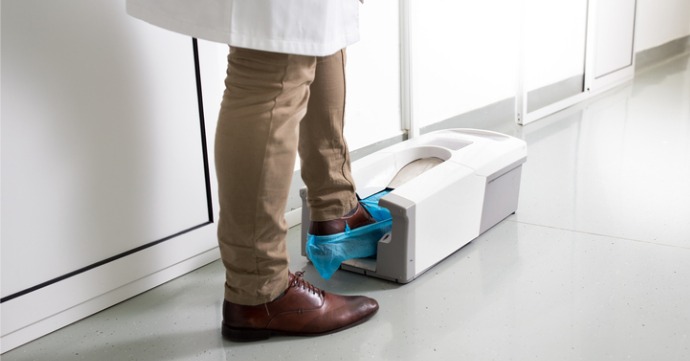
Most laboratories are carefully controlled environments. The equipment may include self-closing doors, hands-free sinks, and directional airflow to reduce the risk of contamination. Standard operating procedures aim at producing consistent behavioural practices amongst staff. Lab Personal Protective Equipment (PPE) can include lab coats, aprons, scrubs, gloves, safety glasses or splash goggles, enclosed shoes, and shoe covers and caps to protect the user, the environment, and even those outside the lab.
Why use Lab PPE?
PPE protects the wearer from hazards and hazardous materials that are present inƒ a lab. PPE also protects the lab’s environment from contamination that workers may bring in and can protect the community from harmful material that can attach to workers’ clothing or footwear from the lab.
Contamination Risk From Clothing & Footwear
Our clothes and shoes hold all kinds of matter that can enter a laboratory. Contamination of the lab and specimens can occur when particles fall off clothing. Clothing can act as a vehicle for transferring things like pollen, dust, fibres, hair, pet fur and dander, chemical pollutants, bacteria, viruses, and fungi. As the wearer moves around the lab, these particles can come off their clothes, into the air, and settle on surfaces causing potential contamination. Fully covering clothing with PPE overalls ensures contaminants can’t escape from clothing.
Footwear can harbour plenty of nasty bacteria. A study found there’s an average of 421,000 units of bacteria on the outside of shoes. The bacteria and viruses on shoes can include Clostridium Difficile, Staphylococcus Aureus, COVID-19, Micrococcus, Bacillus, and Pseudomonas. Shoes pick up bacteria from dog faeces, bird faecal matter, toilet floors, footpaths and more. The only way of ensuring these bacteria and viruses don’t enter a laboratory is to remove shoes worn outside the lab or to cover them with shoe protectors.
Why Wear Shoe Covers
There are various reasons why organisations ensure workers wear shoe covers whenever they’re in a laboratory.
Slip and Fall Protection
Laboratory flooring must be impermeable non-absorbent surfaces that can be easily cleaned and sanitised. These properties mean some laboratory flooring can be slippery when wet. Anti-slip shoe covers or shoe covers with a grip on the sole can protect from slips and falls on a wet surface.
Shoe Protection for Workers
Most laboratories require workers to wear closed-toe shoes to protect their feet from chemicals or injuries from falling objects.
Laboratories can work with a range of substances, from dangerous chemicals to human and animal bodily fluids. Accidents happen, and fluids can spill at any time. Those people who work with dangerous chemicals may need to wear chemical-resistant shoes.
When fluids spill it can splash onto shoes, or a worker may walk through it. The event can cause a risk of contaminating another part of the building, the community, or the worker’s home, even after cleaning. When wearing waterproof shoe cover , the shoes are not compromised and are safe to continue wearing. Instead of damaging expensive pairs of shoes, it is better to use highly affordable shoe covers.
Peace of Mind That Shoes are Clean
Even without the event of a spill, the lab floor can contain "invisible" harmful bacteria. Soles and shoes collect the bacteria, and after long working hours, workers are at risk of contaminating their home's floor. No one wants to take that type of work home with them!
Providing workers with shoe covers means they have peace of mind knowing that their shoes are safe from potentially harmful bacteria or viruses at the end of their shift.
Protect the Community
There is always the potential of hazardous material from a laboratory accidentally making its way out into the world. With the speculation that the COVID-19 virus started in a lab rather than a wet market, the general population is now better informed about the potential risks of laboratories.
Laboratory staff are responsible for keeping what they work with inside the laboratory. By wearing PPE in the laboratory and removing the PPE before leaving the laboratory, there is less risk of a worker becoming a host and carrying a virus or bacteria out of the lab on their clothing, hands, or shoes. PPE acts as a barrier between the biological agent and the body of a lab worker.
Protective shoe covers and dispensers are perfect for laboratories and to enhance safety measures. To find out why and for more information, get in touch with Helix Solutions at 1300 29 32 32 or contact us online.